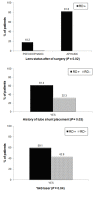Retinal detachments after Boston Keratoprosthesis: incidence, predisposing factors, and visual outcomes
- PMID: 27330474
- PMCID: PMC4902639
- DOI: 10.5693/djo.01.2015.10.001
Retinal detachments after Boston Keratoprosthesis: incidence, predisposing factors, and visual outcomes
Abstract
Purpose: To determine the rates, predisposing factors, and visual outcomes of retinal detachment (RD) after Boston Keratoprosthesis (KPro) implantation.
Methods: In this noncomparative, interventional case series, the medical records of 170 patients (205 eyes) who underwent Boston type 1 and type 2 KPro implantation at the Massachusetts Eye and Ear Infirmary between April 1993 and June 2009 were retrospectively reviewed. Incidence and annual rates of RD were calculated, and the roles of possible predictive factors for RD after KPro were investigated. Main outcome measures were rates of and risk factors for RD, visual acuity after RD, and surgical outcomes after repair.
Results: Sterile vitritis and autoimmune systemic disease significantly predisposed patients to RD after KPro placement. Of patients who developed RD after implantation, 50% progressed to visual acuity of no light perception despite surgical repair.
Conclusions: Inflammation plays a major role in RD development after KPro implantation. Patients with predisposing factors should be advised of the high rates of RD and comanaged with a vitreoretinal specialist.
Figures


References
-
- Zerbe BL, Belin MW, Ciolino JB. Results from the Multicenter Boston Type 1 Keratoprosthesis Study. Ophthalmology. 2006;113:1779–84. - PubMed
-
- Sayegh RR, Ang LPK, Foster S, Dohlman CH. The Boston Keratoprosthesis in Stevens Johnson syndrome. Am J Ophthalmol. 2008;145:438–44. - PubMed
-
- Aldave AJ, Kamal KM, Vo RC, Yu F. The Boston type 1 keratoprosthesis. Improving outcomes and expanding indications. Ophthalmology. 2009;116:640–51. - PubMed
-
- Harissi-Dagher M, Dohlman CH. The Boston Keratoprosthesis in severe ocular trauma. Can J Ophthalmol. 2008;43:165–9. - PubMed
-
- Bradley JC, Hernandez EG, Schwab IR, Mannis MJ. Boston type 1 keratoprosthesis: the University of California Davis experience. Cornea. 2009;28:321–7. - PubMed
MeSH terms
LinkOut - more resources
Full Text Sources
Other Literature Sources
Medical
Miscellaneous
